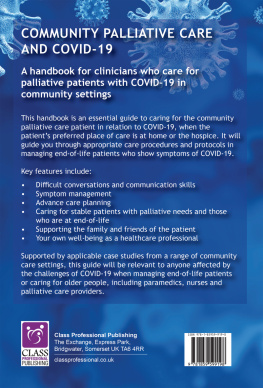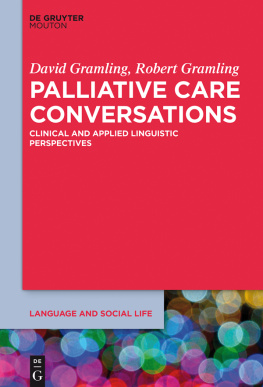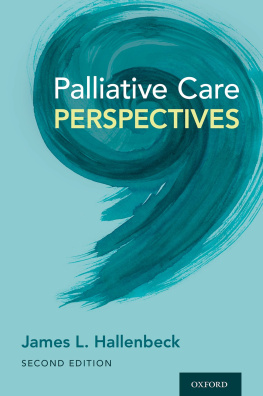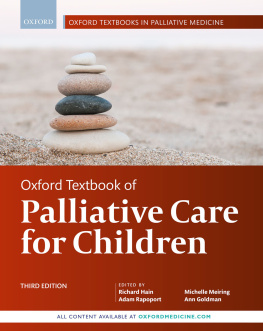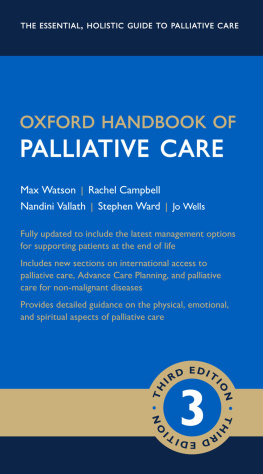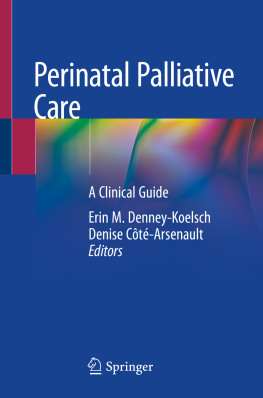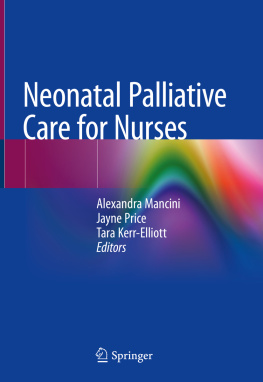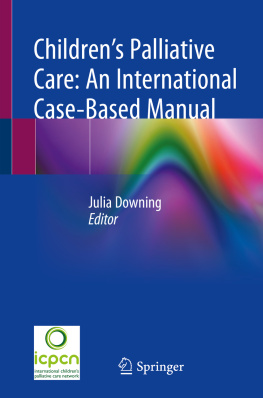Tania Blackmore - Community Palliative Care and COVID-19
Here you can read online Tania Blackmore - Community Palliative Care and COVID-19 full text of the book (entire story) in english for free. Download pdf and epub, get meaning, cover and reviews about this ebook. year: 2021, publisher: Book Network Intl Limited trading as NBN International (NBNi), genre: Home and family. Description of the work, (preface) as well as reviews are available. Best literature library LitArk.com created for fans of good reading and offers a wide selection of genres:
Romance novel
Science fiction
Adventure
Detective
Science
History
Home and family
Prose
Art
Politics
Computer
Non-fiction
Religion
Business
Children
Humor
Choose a favorite category and find really read worthwhile books. Enjoy immersion in the world of imagination, feel the emotions of the characters or learn something new for yourself, make an fascinating discovery.
- Book:Community Palliative Care and COVID-19
- Author:
- Publisher:Book Network Intl Limited trading as NBN International (NBNi)
- Genre:
- Year:2021
- Rating:5 / 5
- Favourites:Add to favourites
- Your mark:
- 100
- 1
- 2
- 3
- 4
- 5
Community Palliative Care and COVID-19: summary, description and annotation
We offer to read an annotation, description, summary or preface (depends on what the author of the book "Community Palliative Care and COVID-19" wrote himself). If you haven't found the necessary information about the book — write in the comments, we will try to find it.
Community Palliative Care and COVID-19 — read online for free the complete book (whole text) full work
Below is the text of the book, divided by pages. System saving the place of the last page read, allows you to conveniently read the book "Community Palliative Care and COVID-19" online for free, without having to search again every time where you left off. Put a bookmark, and you can go to the page where you finished reading at any time.
Font size:
Interval:
Bookmark:
Abel, J., Kellehear, A., Millington Sanders, C., Taubert, M. and Kingston, H. (2020). Advance care planning re-imagined: a needed shift for COVID times and beyond. Palliative Care and Social Practice, 14, 2632352420934491. doi:10.1177/2632352420934491
Annachiara, M., Pasquale, B., Maria, V., Carmine, I., Ely, E. W. and Giuseppe, S. (2020). How COVID-19 pandemic changed our communication with families: losing nonverbal cues. Critical Care (London, England), 24(1), 12. doi:10.1186/s13054-020-03035-w
Arya, A., Buchman, S., Gagnon, B. and Downar, J. (2020). Pandemic palliative care: beyond ventilators and saving lives. CMAJ: Canadian Medical Association Journal, 192(15), E400. doi:10.1503/cmaj.200465
Back, A., Tulsky, J. A., and Arnold, R. M. (2020a). Communication skills in the age of COVID-19. Annals of Internal Medicine, 172(11). doi:10.7326/M20-1376
BGS (2020). COVID-19: Managing the COVID-19 pandemic in care homes for older people. The Bristish Geriatric Society: https://www.bgs.org.uk/resources/covid-19-managing-the-covid-19-pandemic-in-care-homes
Block, B. L., Smith, A. K. and Sudore, R. L. (2020). During COVID-19, outpatient advance care planning is imperative: we need all hands on deck. Journal of the American Geriatrics Society. doi:10.1111/jgs.16532
BMJ (2020). Coronavirus disease 2019 (COVID-19). BMJ Best Practice. Available: https://bestpractice.bmj.com/topics/en-gb/3000201/management-recommendations#referencePop3
Borasio, G. D., Gamondi, C., Obrist, M., Jox, R. (2020). COVID-19: decision making and palliative care. Swiss Medical Weekly, 150, w20233. doi:10.4414/smw.2020.20233
Bowlby, J. (1988). A Secure Base: Clinical Applications of Attachment Theory. London: Routledge.
Bowman, B. A., Esch, A. E., Back, A. L. and Marshall, N. (2020). Crisis symptom management and patient communication protocols are important tools for all clinicians responding to COVID-19. Journal of Pain and Symptom Management. doi:10.1016/j.jpainsymman.2020.03.028
Brown-Johnson, C., Vilendrer, S., Heffernan, M. B., Winter, S., Khong, T., Reidy, J. and Asch, S. M. (2020). PPE portraits a way to humanize personal protective equipment. Journal of General Internal Medicine. doi:10.1007/s11606-020-05875-2
Calton, B., Abedini, N., and Fratkin, M. (2020). Telemedicine in the time of coronavirus. Journal of Pain and Symptom Management. doi:10.1016/j. jpainsymman.2020.03.019
Carr, D., Boerner, K., and Moorman, S. (2020). Bereavement in the time of coronavirus: unprecedented challenges demand novel interventions. Journal of Aging and Social Policy, 17. doi:10.1080/08959420.2020.1764320
Chidiac, C., Feuer, D., Naismith, J., Flatley, M. and Preston, N. (2020). Emergency palliative care planning and support in a COVID-19 pandemic. Journal of Palliative Medicine. doi:10.1089/jpm.2020.0195
Chong, E., Chan, M., Tan, H. N. and Lim, W. S. (2020). COVID-19: Use of the Clinical Frailty Scale for critical care decisions. Journal of the American Geriatrics Society. doi:10.1111/jgs.16528
Costantini, M., Sleeman, K. E., Peruselli, C. and Higginson, I. J. (2020). Response and role of palliative care during the COVID-19 pandemic: a national telephone survey of hospices in Italy. Palliative Medicine. doi:10.1177/0269216320920780
Courtney, E. (2020). Advance care planning and treatment escalation plans. InnovAiT, 13(2), 109116. doi:10.1177/1755738019890116
Daly, M. (2020). COVID-19 and care homes in England: What happened and why? Social Policy& Administration, n/a(n/a). doi:10.1111/spol.12645
Darvall, J., et al. (2020). Frailty and outcomes from pneumonia in critical illness: a population-based cohort study. Critical Care, 125(5): 730738.
Department of Health and Social Care (2017). Guidance: Pandemic Flu. Available at: https://www.gov.uk/guidance/pandemic-flu#ethical-framework [Accessed: July 2020].
Department of Health and Social Care (2020a). Guidance for those who provide unpaid care to friends or family. Available: https://www.gov.uk/government/publications/coronavirus-covid-19-providing-unpaid-care/guidance-for-those-who-provide-unpaid-care-to-friends-or-family [Accessed: July 2020].
Department of Health and Social Care (2020b). Coronavirus (COVID-19): Reuse of medicines in a care home or hospice. Available: https://www.gov.uk/government/publications/coronavirus-covid-19-reuse-of-medicines-in-a-care-home-or-hospice
Department of Health and Social Care (2020c). Coronavirus (COVID-19): verifying death in times of emergency https://www.gov.uk/government/publications/coronavirus-covid-19-verification-of-death-in-times-of-emergency/coronavirus-covid-19-verifying-death-in-times-of-emergency#key-resources
Etkind, S. N., Bone, A. E., Lovell, N., Cripps, R. L., Harding, R., Higginson, I. J. and Sleeman, K. E. (2020). The role and response of palliative care and hospice services in epidemics and pandemics: a rapid review to inform practice during the COVID-19 pandemic. Journal of Pain and Symptom Management. doi:10.1016/j. jpainsymman.2020.03.029
Ferguson, L. and Barham, D. (2020). Palliative care pandemic pack: a specialist palliative care service response to planning the COVID-19 pandemic. Journal of Pain and Symptom Management. doi:10.1016/j. jpainsymman.2020.03.026
Galvan Casas, C. and Catala, A. (2020). Classification of the cutaneous manifestations of COVID-19: a rapid prospective nationwide consensus study in Spain with 375 cases. British Journal of Dermatology Available at: https://onlinelibrary.wiley.com/doi/pdf/10.1111/bjd.19163
Garg, P., Arora, U., Kumar, A. and Wig, N. (2020). The Post-COVID Syndrome: How Deep is the Damage? Journal of Medical Virology. doi:10.1002/jmv.26465
Gattinoni, L., Chiumello, D., Caironi, P. et al. (2020). COVID-19 pneumonia: different respiratory treatments for different phenotypes? Intensive Care Med, 46, 10991102. https://doi.org/10.1007/s00134-020-06033-2.
Gibbon, L. M., Graybuck, K. E., Buck, L. I., Huang, K.-N., Penumarthy, N. L., Wu, S. and Curtis, J. R. (2020). Development and implementation of a clinician-facing prognostic communication tool for patients with COVID-19 and critical illness. Journal of Pain and Symptom Management. doi:10.1016/j.jpainsymman.2020.05.005
GMC (2020). Joint statement: Community-based prescribing for COVID-19 symptoms. Available: https://www.gmc-uk.org/news/news-archive/joint-statement--community-based-prescribing-for-covid-19-symptoms
Gordon, A. L. et al. (2020). Commentary: COVID in care homes challenges and dilemmas in healthcare delivery. Age and Ageing. doi:10.1093/ageing/afaa113
Graham N. et al. (2020). SARS-CoV-2 infection, clinical features and outcome of COVID-19 in United Kingdom nursing homes. Journal of Infection. doi: 10.1016/j.jinf.2020.05.073
Greenhalgh, T., Knight, M., ACourt, C., Buxton, M. and Husain, L. (2020). Management of post-acute covid-19 in primary care. BMJ, 370, m3026. doi:10.1136/bmj.m3026
Hayhoe, B. and Howe, A. (2011). Advance care planning under the Mental Capacity Act 2005 in primary care. British Journal of General Practice, 61(589), e537-e541. doi:10.3399/bjgp11X588592
Hopkins, S. A., Lovick, R., Polak, L., Bowers, B., Morgan, T., Kelly, M. P. and Barclay, S. (2020). Reassessing advance care planning in the light of COVID-19. BMJ, 369, m1927. doi:10.1136/bmj. m1927
Hospice UK (2020). Available: https://www.hospiceuk.org/what-we-offer/publications?kwrd=care%20after%20death&cat=72e54312-4ccd-608d-ad24-ff0000fd3330
ICNARC (2020). COVID-19 Report: Available at: https://www.icnarc.org/Our-Audit/Audits/Cmp/Reports
Jonathan, D. S., Maura, K., Emily, L. A., Joshua, J. B., Ali, S. R., Bryan, J. Y. and Benjamin, A. W. (2020). Humanism in the age of COVID-19: renewing focus on communication and compassion.
Font size:
Interval:
Bookmark:
Similar books «Community Palliative Care and COVID-19»
Look at similar books to Community Palliative Care and COVID-19. We have selected literature similar in name and meaning in the hope of providing readers with more options to find new, interesting, not yet read works.
Discussion, reviews of the book Community Palliative Care and COVID-19 and just readers' own opinions. Leave your comments, write what you think about the work, its meaning or the main characters. Specify what exactly you liked and what you didn't like, and why you think so.

